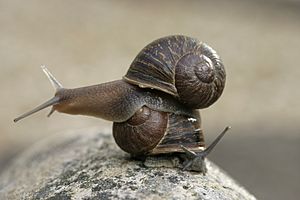Jeremy (snail) facts for kids

Jeremy the left-coiling snail on top of a right-coiling snail, Bree.
|
|
| Species | Cornu aspersum |
|---|---|
| Breed | Sinistral |
| Sex | Hermaphrodite |
| Hatched | London, UK |
| Died | 11 October 2017 |
| Owner | University of Nottingham |
| Residence | United Kingdom |
| Offspring | 56 |
| Appearance | Left-coiled |
| Named after | Jeremy Corbyn |
Jeremy was a left-coiled garden snail investigated by biologists. Jeremy died on 11 October 2017, aged "at least two" years. The snail had a rare genetic mutation which caused its shell to coil to the left; in most snails the shell coils to the right. Environmental factors may have caused the left coiling although it is not definitely proven to be a factor and is considered unlikely. This probable mutation is extremely rare, believed to only occur once in a million individuals. The snail was named after the left-wing British Labour politician Jeremy Corbyn, on account of it being a "lefty" snail, but also due to Corbyn's reported love of gardening. The snail became famous worldwide after a public appeal to find other left-coiled snails for a mate.
As a rare genetic mutation, the snail was studied by researchers from the University of Nottingham. It is hoped that genes identified from this snail and its offspring will help scientists unlock genetic markers in humans and other animals.
Jeremy is the focus of the documentary Jeremy the Lefty Snail and Other Asymmetrical Animals.
In 2018, the podcast This is Love released an episode about Jeremy, "One in a Million."
Contents
Life
A retired scientist found the snail in southwest London. He contacted the University of Nottingham and sent them the snail. A group of researchers, led by "resident snail expert" Dr Angus Davison, then launched a public appeal to find another 'lefty' snail as a mate. Due to the unique positioning of the reproductive body parts in anticlockwise-coiled snails, they are only able to mate with snails that also have anticlockwise shells. Two other anticlockwise snails were discovered and sent to the university; however, these two snails mated with each other instead, producing 170 right-coiled 'normal' snails. One of the left-coiled snails later mated with Jeremy, producing 56 offspring, all of which were also 'normal' with right-coiling shells.
It is believed that the genetic mutation might reappear in a later generation due to a recessive gene. In snails, shell-coiling direction is thought to be an example of a maternal effect – a trait that is determined not by an organism's own genotype, but by the genotype of its mother. In this case, Jeremy's mother (who likely possessed a normal, clockwise shell), would have had two copies of the recessive gene, expressed in Jeremy's anticlockwise shell. Jeremy, with only one copy of the gene, would be expected to mother normal snails. This recessive trait may reappear later in another generation, even if a previous generation appears normal, because the mutation is hereditary.
Further research
While studying this snail, Davison discovered a gene that determined whether a snail's shell coiled to the left or to the right. He said that body asymmetry in humans and other animals could be affected by the same gene and that the research could help understand the positioning of organs according to genetic markers.
Davison was quoted as saying:
This may be the end for Jeremy, but now the snail has finally produced offspring, this is a point in our long-term research goal. Ultimately, we would like to know why these snails are so rare, but also how the left and right sides of the body are signalled at the molecular level, and whether a similar process is taking place during human development.
Research was expected to continue on the offspring of these snails, and the University of Nottingham had seven left-coiled snails by October 2017.
In July 2018, the research team at the University of Nottingham announced the arrival of St Stephen, a 'lefty' snail of the species Cepaea nemoralis and stated in a tweet that they were looking for potential mates.
It was hoped that this research will lead to insights into rare conditions like Situs inversus and Situs ambiguus where the positioning of organs in the body is reversed or misplaced due to genetic malformations.
Sinistral snails
Jeremy was an example of a rare sinistral snail in a species which normally has right-handed shell-coiling. However, in some other species of snail, the counterclockwise shell-coiling is quite common, and in a few cases counterclockwise shell coiling is the normal direction.
See also
 In Spanish: Jeremy (caracol) para niños
In Spanish: Jeremy (caracol) para niños

